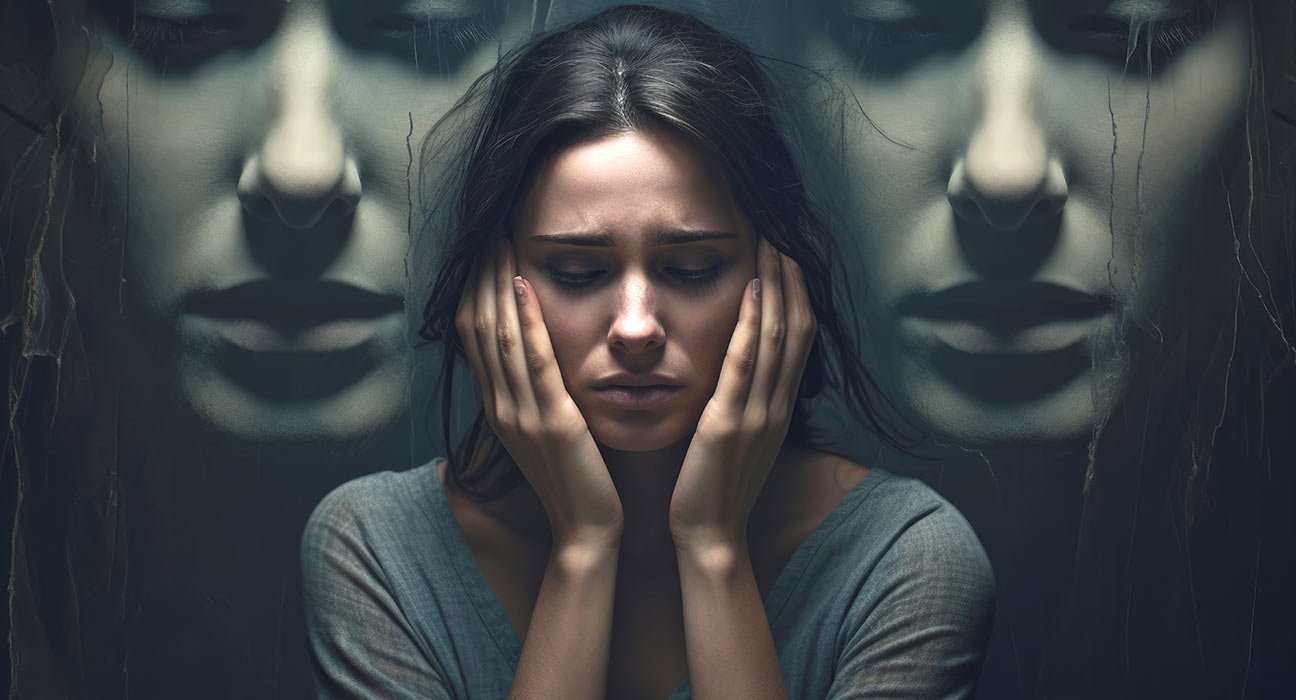Bipolar disorder (formerly: manic-depressive illness) is a mental disorder that causes changes in a person’s metabolism, emotional states, concentration and more. People with this disorder go through mood episodes. These are bouts of intense emotional phases, which may last for days or weeks. These periods could be neutral, hypomanic, manic, or depressive. This prevents people with this disorder from living their lives to the fullest.
Manic phases typically entail an abnormally irritable or joyous mood. One feels overly happy, jumpy, and sure of everything. As a natural extension, reckless or impulsive decision-making and irritability could also be involved. This results in a lot of people experiencing hallucinations (sensing imaginary things) or being stuck in delusions (strong belief in things that aren’t true).
Hypomania and Depressive Periods
Hypomania exhibits milder symptoms of mania, in which someone does not experience delusions or hallucinations, and most symptoms do not hugely impact their everyday life. This form of mania can be deceptive as it often feels like a surge in positive energy that can even enhance productivity & creativity. As a result, a person going through this period may deny that anything is wrong.
On the other hand, depressive periods are morose. The person feels very sad. The symptoms resemble those of major depressive disorder. Most people with bipolar disorder have longer depressive cycles than neutral or happy. Most people experience mood fluctuations, however, for people without bipolar disorder, mood changes typically last only for hours. Also, these changes don’t imply the extreme degree of behaviour change or difficulty with daily routines and social interactions that people with bipolar disorder have. The disorder can disrupt a person’s relationships with loved ones and cause difficulty in working.
The Bipolar Disorder Survival Guide: What You and Your Family Need to know; You can also refer to this book written by David J. Miklowitz. It is a comprehensive guide for the patient and the family to deal with the challenges.
Other books on Bipolar Disorder
Types of Bipolar disorder
Bipolar disorder is an umbrella term for three different diagnoses: Bipolar I, Bipolar II, and Cyclothymic disorder. All types involve clear changes in mood, energy, and activity levels.
Bipolar I Disorder
Bipolar I disorder is characterised by a history of at least one manic episode, sometimes depressed or hypomanic episodes also occur, and episodes of depression with manic features simultaneously are a possibility as well. The manic episodes typically last for at least a week. The symptoms are severe enough to warrant immediate medical care. The depressive episodes (if any) typically last at least 2 weeks. People with Bipolar I disorder frequently have co-occurring mental disorders like anxiety disorders, substance use disorders, or attention-deficit/hyperactivity disorder (ADHD). The risk of suicide is significantly high.
Bipolar II Disorder
Bipolar II disorder is characterised by at least one major depressive episode and at least one hypomanic episode. People return to their usual functioning between episodes. They often first seek treatment as a result of their first depressive episode. This is because the hypomanic episodes are ignored often as they can feel pleasurable and even increase performance at work or school. Mood states follow hypomanic cycles, where depressive episodes may be just as severe as those in a Major Depressive Disorder and/or Bipolar I Disorder. People with Bipolar II disorder also frequently have other mental illnesses similar to Bipolar I. If bipolar disorder and alcohol use disorder happen at the same time, it is labelled as a “dual diagnosis” and requires help from a specialist who can address both issues.
Read: 5 Phases of Alcohol Addiction
Cyclothymic Disorder
Cyclothymia is a milder form of bipolar disorder with recurring “mood swings” between hypomania and depressive symptoms. Since these symptoms are less severe than Bipolar I or II disorders, don’t qualify as mania or depression. Another important term related to Bipolar disorder is Rapid cycling. The term is used to describe the course of illness in people with both kinds of bipolar disorders. It is common and happens when mood changes occur four or more times within a year. A person may also experience the symptoms of the disorders that do not fall into any of these categories. They are called “other specified and unspecified bipolar and related disorders”.
Read More: Mood Disorders in a Modern World
Symptoms of Bipolar disorder
Often without recognizing their harmful or undesirable effects, people with bipolar disorder engage in behaviours that are not regular for them. They experience periods of unusually intense emotion and changes in sleep patterns and activity levels. These are reflected in mood episodes, during an episode the symptoms last for most of the day.
A. Manic episode symptoms:
As explained above, manic episodes are a period defined by at least one week when a person is extremely high-spirited or irritable and experiences at least three of the following changes in behaviour. They must represent a change from the person’s usual behaviour and are severe enough to cause dysfunction in work, family, or social activities and responsibilities.
- Increased elation, happiness, power etc. leading to a decreased need for sleep (feeling energetic despite sleeping less than usual).
- Being more prone to distractions and risky behaviour e.g. reckless driving, spending etc.
- Increased activity, restlessness, and unusually high multitasking without getting tired.
- Increased speech speed & content. This is also shown in uncontrolled racing thoughts or in talking fast about a lot of different things (“flight of ideas”).
- Some people experiencing manic episodes also experience disorganised thinking apart from hallucinations & delusions known as psychotic features.
- Excessive appetite for food, drinking, sex, or other pleasurable activities
B. Depressive episode symptoms:
A major depressive episode is at least two weeks in which a person has at least five of the following symptoms (including at least one of the first two major symptoms):
- Intense sadness, despair, or anxiety.
- Loss of interest in activities the person once enjoyed.
- Fatigue i.e. Feeling unable to do even simple things or lack of interest in almost all activities.
- Having trouble falling asleep and increased/decreased sleep.
- Increased or decreased appetite.
- Restlessness (e.g. pacing) and difficulty in concentrating or making decisions.
- Slowed speech or movement, feeling unable to find anything to say, or forgetting a lot.
- Feelings of worthlessness or guilt, death or suicide etc.
C. Hypomanic Episode symptoms:
A hypomanic episode is characterised by less severe manic symptoms that last only four days in a row rather than a week. These don’t lead to major problems in daily functioning.
D. Mixed Episode symptoms:
These occur when people have both manic and depressive symptoms in the same episode. During an episode with mixed features, people may feel very sad, empty, or hopeless while at the same time feeling extremely energised. These could be apparent in increased agitation, trouble sleeping, significant change in appetite, psychosis, and suicidal thinking.
Treatments of Bipolar Disorders
Treatment can help many people, including those with the most severe forms of bipolar disorder. As bipolar disorders are chronic, continual preventive treatment is typically followed. The treatments are individualised and one may need to try different medications in combination with psychotherapy and other methods discussed below, before finding what works best for them:
1. Medication
Medications that target sleep or anxiety are often a part of the treatment plan. Antidepressant medications are the most common prescriptions along with Mood stabilisers. These are believed to correct imbalances in the brain and can help prevent mood episodes or reduce their severity. As a result, these also can decrease the risk of suicide. On the other hand, taking an antidepressant without a mood stabiliser could trigger a manic episode or rapid cycling in a person with bipolar disorder.
2. Psychotherapy
Psychotherapy (talk therapy) can be an effective part of treatment, it covers treatment techniques that help people identify and change irritating feelings, thoughts, and behaviours. This part of the therapy can provide literacy, a guiding hand, and a firm shoulder for people with bipolar disorder and their families. As an example, cognitive behavioural therapy (CBT) is a psycho-social intervention prescribed for depression. It has been adapted for the treatment of insomnia and is thus especially helpful as part of treatment for bipolar depression.
3. Neuromodulation
These are used when medication and psychotherapy have not helped e.g. when a person’s illness has not improved after other treatments, or where rapid response is needed (people who have a high suicide risk). It is still an evolving field that employs the direct delivery of drugs or electrical stimuli to the nervous system, The following are some types:
4. ECT
Electroconvulsive therapy (ECT) consists of multiple rounds of a quick electrical current passed to the scalp of a patient under anaesthesia. This leads to short and controlled seizures which are believed to remodel brain signalling pathways. It can thus help relieve severe symptoms.
5. rTMS
Although not as powerful as ECT, repetitive transcranial magnetic stimulation (rTMS) is another type of brain stimulation that uses magnetic waves to relieve depression over a series of treatment sessions. Thus this does not require anaesthesia and has a lower risk of deterioration of memory and thinking.
6. Family support groups
A part of treating people with bipolar disorders is rebuilding the strength and awareness of their near and dear ones. As they could have been disrupted, been in stressful situations etc. Professional mental health advocacy and support groups can help the close ones to employ strategies for coping, tips on how to make their participation more active and conducive, and also give them emotional support for the same.
7. Others
Some therapeutic value is seen from nutritional approaches too. Omega-3 fatty acids are an example, studies show that they may help lower dosages of other medications. They play a role in the nervous system functions and bake into brain cell membrane structure.
Awareness of Bipolar Disorder
Facts, Myths, and Ongoing Support Bipolar disorder is a complex mental health condition. While specific brain mechanisms underlying the condition remain unclear, an imbalance of chemicals plays a role, and environmental factors such as stress, drugs, and alcohol can trigger mood episodes in susceptible individuals. It affects individuals of different ages, often with an onset at 25 years of age. It commonly runs in families and about 80-90% of individuals with bipolar disorder have a relative with bipolar disorder or depression.
It is thus important to study this closely and be aware of the symptoms, treatments, and support mechanisms. People with bipolar disorder often seek help when they are in a depressive state (more than manic or hypomanic experiences), which makes it essential for healthcare providers to conduct thorough medical histories to differentiate between bipolar disorder and depression accurately.
Misconceptions
Therapy is equally as important as detecting & accurately identifying bipolar disorder. Misconceptions about bipolar disorder like losing creativity, productivity, and individuality or that mania is always a positive state (not depressed), can all deter people from neglecting treatment to preserve manic energy which can burst out and endanger a person’s well-being in general. Even after successfully trusting and starting therapy, one needs to understand that resultant stability is not where it stops. Since this is a chronic condition, one needs to maintain this stability by slowly changing and adapting to a healthier lifestyle, being aware of triggers and weeding them out etc.
Finally, misconceptions around people with bipolar disorders about their actions being voluntary can cause more harm. They may engage in ignorant and foolish actions which are dangerous to themselves or others, but the actions are generally not voluntary and their faculties are mostly out of their control. Thus increasing awareness about these intricacies and reducing the stigma is essential to promote early diagnosis, intervention, and constructive ongoing support by families and loved ones.













Leave feedback about this